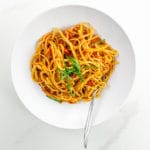Spaghetti al Pomodoro (with Tomato Sauce)
This relatively quick, largely hands-off weeknight dinner has been a staple of my life for as long as I can remember. I hope our spaghetti al pomodoro will become a regular in your repertoire, too.
Calories: 462kcal
Ingredients
- 2 tablespoons (30 ml) olive oil
- 1 medium yellow onion diced very small
- 8 medium cloves garlic chopped
- 26.4 ounces (748 grams) strained tomatoes
- 26.4 ounces (748 grams) chopped tomatoes
- 1 tablespoon (12 grams) sugar
- 2 teaspoons (10 grams) fine sea salt, if tomatoes are unsalted
- ½ teaspoon about (3 grams) freshly ground black pepper
- 2 tablespoons (28 grams) butter
- 1 pound (454 grams) spaghetti or other pasta of your choice
Instructions
- Warm the olive oil in a 5 ½-quart Dutch oven or other good-sized heavy pot over medium-high heat.
- Add the onion, garlic, and half the salt and cook, stirring occasionally, until softened, about 5 minutes.
- Pour in the tomato sauce, chopped tomatoes, remaining salt, pepper, and sugar and stir well.
- Cover and bring to a boil, then reduce heat to simmer for 20 to 30 minutes, stirring occasionally.
- Uncover, reduce heat to a bare simmer and stir in the butter. Taste for salt.
- With 15 minutes of cooking time to go, bring a large pot of well-salted water to a boil, then cook spaghetti until al dente according to package directions. Scoop out and reserve half a cup of the cooking water, then drain.
- To finish family style, return the pasta to its pot and set back on the warm burner (without turning it on). Ladle in some of the sauce, pour in a bit of the pasta cooking water, and toss to coat.
- Or, to finish restaurant style, ladle one serving of sauce into a frying pan and set over medium heat. Pour in a little bit of pasta cooking water and add one serving of cooked pasta. Toss it all together with tongs to coat, then transfer to a serving bowl.
Notes
- Good-quality canned (or boxed) tomatoes make this sauce achievable at all times of year and with greatly reduced cooking time. Over the years I've gravitated toward Pomi tomatoes from Italy, but you can use your favorites. I use 50% strained tomatoes (also called tomato purée or passata di pomodoro, depending on the brand). You can also use unseasoned tomato sauce, which is similar but typically hasn't been cooked down to thicken. I use 50% chopped tomatoes (also called diced tomatoes), because I like the little bit of texture, and also because the combination of these two ingredients allows you to cook at a slightly higher heat without risking spattering or burning. You can use 100% strained tomatoes instead if you like — just keep an eye on the heat and stir frequently. Do not substitute fresh tomatoes in this recipe.
- Dice the onion very small so it doesn't have a major impact on the sauce's texture.
- I use a lot of garlic because I like it. You can reduce the amount if you prefer.
- The little bit of sugar in this recipe is like an insurance policy that guards against imperfectly sweet tomatoes. You can leave it out if you prefer.
- If you like, tuck in some fresh basil leaves or two innermost celery ribs with their leaves when you add the tomatoes.
- Swirling in a little butter after cooking adds a wonderful roundness and dimension to the sauce, but you can leave that out, too, if you'd rather.
- Serve with fresh basil to garish and grated pecorino or parmesan cheese to pass at the table, if you like.
- The sauce keeps well in an airtight container in the fridge for a week and in the freezer for up to a year, so you can make it well in advance and easily store leftovers.
- Pasta should be cooked right before serving — but if you have leftovers, you can store them in the fridge for up to a week, too. Reheated pasta will lose its al dente texture, but I have never seen it go to waste.
- I first published this recipe in 2016. I've updated the post for clarity and made a couple of tweaks to the recipe, but the basics remain the same.
Nutrition
Calories: 462kcal | Carbohydrates: 77.8g | Protein: 12.8g | Fat: 12.1g | Fiber: 5.7g
